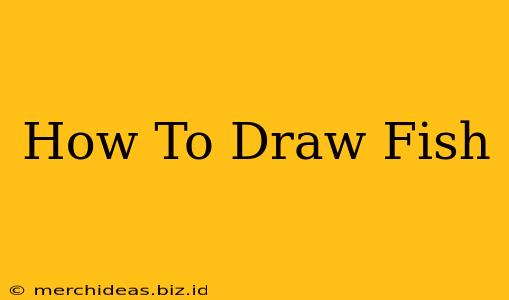So you want to learn how to draw fish? Whether you're a seasoned artist looking to expand your repertoire or a complete beginner picking up a pencil for the first time, this guide will walk you through the process, step-by-step. We'll cover everything from basic shapes to adding intricate details, ensuring you can create realistic and expressive fish drawings.
Understanding Fish Anatomy: The Foundation of Your Drawing
Before we dive into the drawing process itself, it's crucial to understand the basic anatomy of a fish. This knowledge will inform your drawing and allow you to create more believable and lifelike representations. Key features to consider include:
- Body Shape: Fish come in countless shapes and sizes – streamlined torpedo shapes for fast swimmers, flattened bodies for bottom dwellers, and even oddly shaped species for specialized habitats. Observing different fish shapes is key.
- Fins: Fins are crucial for movement and stability. Pay close attention to their placement, size, and shape. Different fin types (dorsal, caudal, pectoral, anal, pelvic) serve different functions.
- Eyes: Fish eyes are often positioned laterally (on the sides of the head), giving them a wide field of vision. Their size and shape can vary greatly depending on the species and environment.
- Mouth: The mouth's shape and position are critical for identifying different fish species. Consider the size, orientation, and presence of any unique features.
- Scales: Scales give fish their distinctive textures. While you won't necessarily draw each individual scale, understanding their pattern and how they overlap is crucial for conveying texture in your drawing.
Step-by-Step Guide to Drawing a Simple Fish
Let's start with a simple, beginner-friendly fish drawing. This will help you build confidence and grasp fundamental drawing techniques.
Step 1: The Basic Shape
Begin by drawing an elongated oval shape. This will form the main body of your fish.
Step 2: Adding the Tail
From one end of the oval, draw a slightly curved, forked shape for the tail fin. Experiment with different tail shapes to create various fish species.
Step 3: Defining the Head
At the opposite end of the oval, draw a smaller, rounded shape for the head.
Step 4: Placement of Fins
Add smaller fins to the top (dorsal fin), bottom (anal fin), and sides (pectoral fins) of the body. Remember to vary their size and shape for a more natural look.
Step 5: Drawing the Eyes
Add two small circles for the eyes, typically positioned on the sides of the head.
Step 6: Adding Details (Optional)
Once you're comfortable with the basic shape, you can start adding details like scales, mouth features, and gill covers.
Drawing More Realistic Fish: Advanced Techniques
Once you've mastered the basics, let's explore techniques for creating more realistic and detailed fish drawings:
- Using Reference Images: The best way to improve your fish drawings is to use reference images. Observe real fish, either in person or through photographs, to study their anatomy and unique characteristics.
- Light and Shadow: Incorporating light and shadow into your drawing is essential for creating depth and realism. Identify the light source and consider how it affects the fish's form.
- Texture: Use shading and line variations to suggest the texture of the scales and skin.
Different Types of Fish to Draw
Experiment with drawing various fish species! Each one presents unique challenges and opportunities to improve your drawing skills. Consider trying these:
- Goldfish: Their simple, rounded shape is perfect for beginners.
- Clownfish: Their vibrant colors and distinctive stripes provide an excellent opportunity to practice color blending.
- Koi: Their flowing shapes and intricate patterns challenge even experienced artists.
- Shark: Their powerful, streamlined bodies present a different challenge in capturing their dynamic form.
Practice Makes Perfect
Drawing fish, like any skill, requires consistent practice. The more you draw, the better you'll become at capturing their unique features and creating lifelike representations. Don't be afraid to experiment, try different techniques, and most importantly, have fun! Remember to use a variety of mediums, such as pencils, charcoal, or even digital art software, to explore your creative style.
